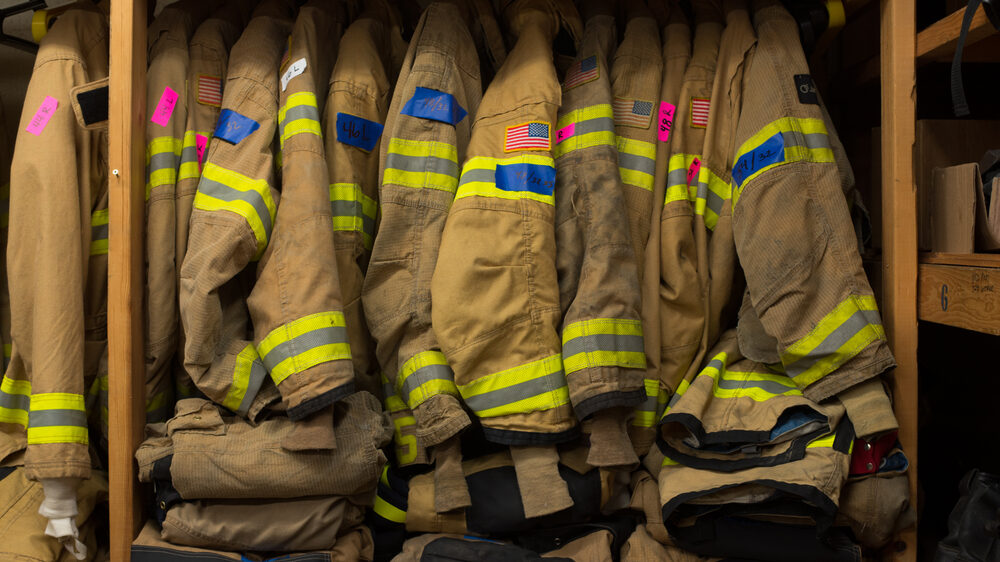NIST reveals increasing PFAS release in firefighter gear due to wear and tear
- January 18, 2024
- 1:25 pm


Iain Hoey
Share this content
Comprehensive studies uncover PFAS presence in firefighter turnout gear
Last year, a study by the National Institute of Standards and Technology (NIST) brought to light the presence of per- and polyfluoroalkyl substances (PFAS) in textiles used in firefighter protective clothing.
These chemicals are known for their association with an increased risk of cancer and other health effects.
Following this revelation, NIST has now released a follow-up study demonstrating that wear and tear on firefighter turnout gear leads to a greater release of PFAS.
Impact of wear and tear on PFAS release in protective clothing analysed
The comprehensive research, spanning two studies, identified the specific PFAS compounds in firefighter gear, their quantities, and the impact of simulated wear and tear on their release.
Rick Davis, a NIST chemist and co-author of the study, shared: “The firefighter community has raised concerns about PFAS in turnout gear, but before these studies, there was very little data that address those concerns.
“Based on these studies we can confidently say that more than 20 types of PFAS might be present in firefighter gear and that the amount and type of PFAS vary depending on the type of textile used and the amount of stress it has been subjected to.”
Potential implications for firefighter safety and gear manufacturing
While the studies do not directly assess the health risks from PFAS in turnout gear, they provide crucial data for health experts to evaluate these risks.
The initiative for these studies stemmed from a directive by Congress in the 2021 National Defense Authorization Act, tasking NIST to investigate PFAS in firefighter gear.
PFAS, due to their resistance to oil, water, and stains, are prevalent in various products, including clothing, furniture, and nonstick cookware.
They are particularly significant in firefighter gear, aiding in water repellency.
However, PFAS are also known as “forever chemicals” due to their environmental persistence.
Studies indicate that most Americans, including firefighters, have detectable PFAS levels in their blood, with firefighters potentially having higher levels and a greater risk for certain cancers, although not necessarily linked directly to PFAS.
The study focused on the textiles in firefighter pants and jackets, comprising three layers: a thermal layer, a moisture barrier, and an outer shell.
Initial analysis involved testing 21 textiles for 53 PFAS compounds.
The follow-up study subjected these textiles to stress through abrasion, heat, laundering, and weathering, including exposure to ultraviolet radiation and high humidity.
The findings revealed that abrasion significantly increased PFAS concentrations across all textiles.
Weathering and heat also elevated PFAS levels in outer shell materials, while laundering had a negligible or slightly reducing effect.
The highest PFAS concentrations were found in outer shell fabrics with water-repellent coatings, and the lowest were in the thermal layers closest to the body.
This research opens potential pathways for manufacturing firefighter gear that meets safety standards while minimising PFAS exposure risks.
Variations in PFAS types and amounts across different manufacturers suggest possible lower-risk combinations.
Alternative methods for achieving required standards without hazardous chemicals are also a possibility.
John Kucklick, another NIST chemist and co-author, remarked: “Using PFAS in turnout gear may or may not be an acceptable risk, given all the other hazards that firefighters already face.
“This data will help people weigh those costs and benefits.”
IFSJ Comment
The latest findings by NIST highlight a critical issue in firefighter safety: the potential health risks posed by PFAS in turnout gear.
The revelation that wear and tear increase PFAS release adds another layer of complexity to the already challenging task of ensuring firefighter safety.
While the studies do not provide a direct link between PFAS and health risks, they furnish vital data for further analysis by health experts.
This development calls for a reevaluation of materials and standards in manufacturing firefighter gear.
The balance between necessary functionality and potential health risks is delicate, demanding informed decisions by manufacturers and oversight bodies.
As firefighting evolves with new challenges and hazards, so must the approach to protective gear, prioritising the health and safety of those who protect our communities.



